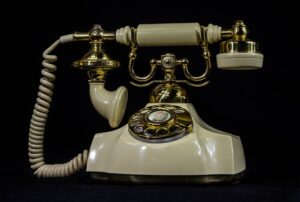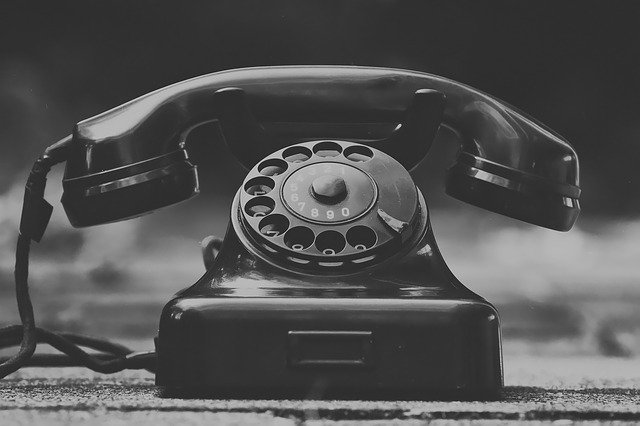
Despite the fact that it is already hard to imagine a world without phone conversations, the invention of equipment capable of sending human speech by wire over long distances has been less than one and a half centuries.
The telephone was created as a result of chance, much like many other things. The story begins in the mid 19th century when the electric telegraph was already known and used.
The invention of the telephone
attributed to three different inventors. Many scientists and historians argue about the rough date of its invention, but most agree that it was invented in 1876.
The truth is that two men, who seem to have been ignorant of each other’s work, presented their ideas at the same time. Both were Americans, and both laid out similar suggestions, but only one of them patented his design before the other.
Who is the “inventor” of the telephone?
Alexander Graham Bell was an English teacher who moved to Boston in 1871 and became a lecturer at Boston University.
The University had just bought a machine for making stencils of letters and phonetic symbols, which enabled Bell to spend his spare time conducting experiments with sound.
He soon became interested in the idea of transmitting speech by electricity.
What did Alexander Graham Bell do?
Alexander drew up a sketch of an electrical device that transmitted speech but had little or no knowledge of how it would work.
He was a great personal organizer, which soon proved to be a significant advantage in gathering the necessary scientific data and financing his invention.
Alexander Graham Bell filed his patent on the telephone on February 14, 1876.
Bell’s first phone call was made on March 10, 1876.
He asked his assistant, Mr. Watson, to join him at one end of the room and shouted “Mr. Watson, come here! I want you!”. At the other end of the room, Mr. Watson heard Bell’s voice clearly and was amazed at this miracle of science.
On February 14, 1876, Alexander Graham Bell filed a patent for “the method of, and apparatus for, transmitting vocal or other sounds telegraphically, by causing electrical undulations, similar in form to the vibrations of the air accompanying the said vocal or other sounds”.
The Telephone Patent Number 174,465 was granted to Bell on March 7, 1876. He called his invention the telephone and it marked man’s first use of electricity for communication.
Famous names who followed Alexander Graham Bell in the development of the telephone were Elisha Gray, Amos E. Dolbear, Thomas A. Edison, and Emile Berliner.
How was the telephone evolved?

In 1876 telephone had no wire and was of a strange shape.
Then it appeared in homes, but its cost prevented the majority from buying the equipment. In 1880 Bell Telephone Company was established in Boston with a capital of $100 000.
Alexander Graham Bell’s new invention became very popular after 1881 when it began to be used for telegraphy. In 1882 a telephone company was opened in New York.
By the end of the 19th century, there were already more than 10 000 telephones in North America, and by the beginning of the 20th century, that number had risen to 100 000.
In the 1880s telegraphy stations began installing telephones for speaking to one another directly. This slowed the telegraph service down.
The invention of the wireless telephone or radiotelephone, which allowed long-distance calls to be made without using wires, was a further development in the history of telephony.
The first experimental wireless telephone system came into existence in 1902 after Guglielmo Marconi built his pioneering station at Bologna.
It was post-World War 1, however, before the first transatlantic wireless telephone conversations took place.
After World War II wireless telephony, especially in the form of cell phone technology, became even more advanced and widespread.
The invention of cordless phones
In 1971 Dr. Martin Cooper invented the world’s first handheld cellular mobile phone. He made the first public call to his rival, Joel S. Engel of Bell Labs, who was making a phone call from a competing Motorola DynaTAC model.
The invention of cordless phones made it possible for people to talk on their phones within 30-40 meters (100 ft.).
Cordless phones also helped to decrease the amount of radiation exposure to users by not confining them to outlets.
The invention of the wireless telephone
The invention of the wireless telephone or radio telephone influenced other inventions that were similar such as walkie-talkies. Radio telephony brought about a revolution in communications.
Users could talk to other people over long distances without the need for a wire, which also allowed the user to move around while talking.
The development of wireless telephones made it possible for police officers and firemen to communicate from inside buildings or from other areas where wires would not reach.
The development of the modern Telephone

The invention of the Cell Phone
In 1973 Martin Cooper invented the world’s first handheld cellular mobile phone. He made the first public call to his rival, Joel S. Engel of Bell Labs, who was making a phone call on a competing Motorola DynaTAC 8000X.
On April 3, 1973, Martin Cooper of Motorola made the first mobile telephone call from a handheld prototype cell phone called DynaTac.
First Cell Phone Model – Motorola DynaTac
Motorola DynaTac is the first commercially available handheld cellular mobile phone.
The Motorola DynaTac 8000X was a clamshell-style cell phone, weighing 2.5 pounds (1.15 kg).
The DynaTac had an LED display with 24 x 40 characters and could store 30 numbers, although it only allowed for voice calls of between 3 and 5 minutes before needing to be recharged.
In April 1983 Motorola introduced the first flip phone, the Comter. It was a cell phone with a flip-out antenna that could fit into a case for transport.
The Motorola Sprint PCS, which debuted in 1996, allowed mobile users to surf the Internet from their mobile phones via its PDA interface.
This was the first time that internet access was available directly from a cellular phone, as opposed to dial-up.
The invention of smartphones
In the 1990s the first prototypes of smartphones were developed. A smartphone is a mobile phone built on a mobile computing platform and has more advanced computing ability and connectivity than contemporary feature phones.
The first smartphone was the IBM Simon Personal Communicator, which was announced in 1992 and released in 1993. It was produced by IBM and had many features similar to a smartphone including email, calendar, address book etc.
Smartphones are currently the most used devices in history after television sets.
A survey conducted in 2012 with 14 000 people revealed that 71% of them own a smartphone.
The first smartphone was IBM Simon
IBM Simon (stylized as “Simon”) is a personal digital assistant (PDA) and the first smartphone.
Released in 1992, it combined several existing technologies into a single handheld device including a fax machine, pager, touchscreen smartphone, email, calendar and address book.
IBM Simon was announced in 1992 and released in 1993. It was the first smartphone to use the OS, such as Windows Mobile and Android, Microsoft’s operating system for mobile devices.
In 1994 IBM introduced two new smartphones, one of them being the IBM Simon Personal Communicator. It used its own operating system but was not a success and soon after that disappeared from the market.
The second device was the IBM Simon 3230 which is considered as part of this generation because it also used IBM’s OS.
The first smartphone to use the Android operating system was HTC Dream, which was released in 2008.
The phone came with Google’s operating system preinstalled and also included a number of programs that provided access to Google’s services.
- See also: what is the history of the guillotine invention
- See also: how was television invented and developed
HTC Dream is one of the first smartphones to use Android OS
The HTC Dream, known as the T-Mobile G1 in the United States, was one of the first phones to use the Android operating system.
It marked Google’s entrance into the mobile phone market and was the first major product that Andy Rubin developed for Google.
Conclusion
The telephone is one of the most important inventions in history. It has let us connect with each other more than ever before and it’s changed how we live, work, learn, play… you name it!
Despite many predictions, the “beep beep” sound is still associated with telephone communication all over the world.
The invention of mobile phones has changed our life a lot.
Cell phones have become an integral part of our life without which people cannot imagine a single day in their lives.



